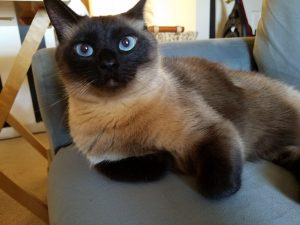Basic information about Tonkinese Cats
Tonkinese cats are a delightful and charming breed known for their playful personalities, striking appearance, and affectionate nature. Here’s an overview of these cuties:
Appearance
- Tonkinese cats have a medium-sized, muscular body with a sleek and elegant appearance. They have a lithe and athletic build, with a fine-boned structure and long, slender legs.
- Their head is slightly rounded with a distinct wedge shape and high cheekbones. They have large, expressive eyes that are typically a vivid blue-green color, giving them an alert and engaging expression.
- The coat of a Tonkinese cat is short, soft, and silky to the touch. It comes in a variety of colors and patterns, including solid, pointed, mink, and sepia. The coat is characterized by a subtle shading or gradient effect, with darker coloration on the points and lighter shading on the body.
- Tonkinese cats have a distinctive coat pattern known as “points,” where the ears, face, paws, and tail are darker in color than the rest of the body. This pattern is similar to that of Siamese cats but may be less extreme in contrast.

Temperament
- Tonkinese cats are known for their playful, outgoing, and affectionate nature. They are intelligent and social cats that enjoy interacting with their human companions and participating in household activities.
- They are often described as being “dog-like” in their loyalty and attachment to their owners. Tonkinese cats form strong bonds with their families and enjoy being involved in family activities.
- Tonkinese cats are vocal and communicative, with a wide range of vocalizations to express their needs and desires. They are not overly loud but will happily engage in conversation with their owners.
- Despite their playful nature, Tonkinese cats are also gentle and affectionate. They enjoy cuddling with their owners and may seek out physical contact and affection.
History
- Tonkinese cats are a relatively modern breed that originated in the mid-20th century in North America. They are a crossbreed between Siamese and Burmese cats, combining the best traits of both breeds.
- The breed was developed by breeders who sought to create a cat with the striking appearance of the Siamese and the affectionate personality of the Burmese. The result was the Tonkinese cat, which quickly gained popularity for its unique combination of beauty and charm.
- Tonkinese cats were officially recognized by major cat associations, including The International Cat Association (TICA) and the Cat Fanciers’ Association (CFA), in the late 20th century. They have since become cherished companions and beloved pets in households around the world.
Care
- Tonkinese cats have short, low-maintenance coats that require minimal grooming. Occasional brushing helps to remove loose hair and distribute natural oils, keeping the coat healthy and shiny.
- Provide a balanced and nutritious diet appropriate for your Tonkinese cat’s age, weight, and activity level. Ensure access to fresh water at all times, and monitor their food intake to prevent obesity.
- Keep your Tonkinese cat mentally and physically stimulated with interactive toys, puzzle feeders, and play sessions. They enjoy climbing, exploring, and engaging in activities that challenge their agile minds and bodies.
- Schedule regular veterinary check-ups to monitor your Tonkinese cat’s health and address any potential issues early on. Keep up with vaccinations, parasite prevention, dental care, and routine blood work as recommended by your veterinarian.
Lifespan
The average lifespan of a Tonkinese cat is typically between 10 to 16 years, though some cats may live longer with proper care and attention. As with any cat breed, factors such as genetics, environment, diet, and veterinary care can all influence the lifespan of an individual cat.

Overall, Tonkinese cats are cherished companions known for their playful personality, affectionate nature, and striking appearance. They make excellent pets for individuals and families alike, bringing warmth, companionship, and joy to their homes for many years.
More posts you might be interested in:

